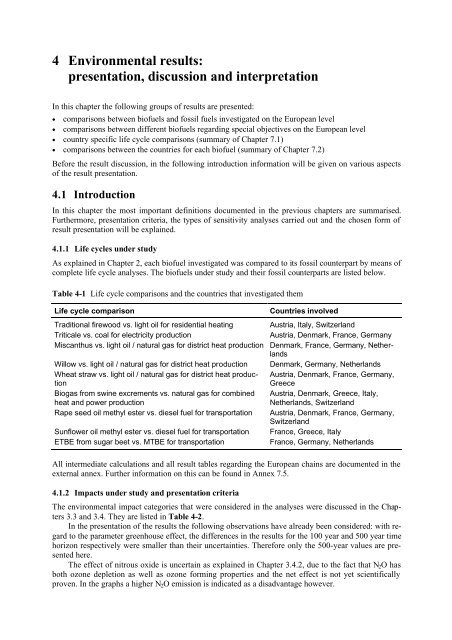BIOENERGY FOR EUROPE: WHICH ONES FIT BEST?
BIOENERGY FOR EUROPE: WHICH ONES FIT BEST?
BIOENERGY FOR EUROPE: WHICH ONES FIT BEST?
You also want an ePaper? Increase the reach of your titles
YUMPU automatically turns print PDFs into web optimized ePapers that Google loves.
4 Environmental results:<br />
presentation, discussion and interpretation<br />
In this chapter the following groups of results are presented:<br />
• comparisons between biofuels and fossil fuels investigated on the European level<br />
• comparisons between different biofuels regarding special objectives on the European level<br />
• country specific life cycle comparisons (summary of Chapter 7.1)<br />
• comparisons between the countries for each biofuel (summary of Chapter 7.2)<br />
Before the result discussion, in the following introduction information will be given on various aspects<br />
of the result presentation.<br />
4.1 Introduction<br />
In this chapter the most important definitions documented in the previous chapters are summarised.<br />
Furthermore, presentation criteria, the types of sensitivity analyses carried out and the chosen form of<br />
result presentation will be explained.<br />
4.1.1 Life cycles under study<br />
As explained in Chapter 2, each biofuel investigated was compared to its fossil counterpart by means of<br />
complete life cycle analyses. The biofuels under study and their fossil counterparts are listed below.<br />
Table 4-1 Life cycle comparisons and the countries that investigated them<br />
Life cycle comparison Countries involved<br />
Traditional firewood vs. light oil for residential heating Austria, Italy, Switzerland<br />
Triticale vs. coal for electricity production Austria, Denmark, France, Germany<br />
Miscanthus vs. light oil / natural gas for district heat production Denmark, France, Germany, Netherlands<br />
Willow vs. light oil / natural gas for district heat production Denmark, Germany, Netherlands<br />
Wheat straw vs. light oil / natural gas for district heat produc- Austria, Denmark, France, Germany,<br />
tion<br />
Greece<br />
Biogas from swine excrements vs. natural gas for combined Austria, Denmark, Greece, Italy,<br />
heat and power production<br />
Netherlands, Switzerland<br />
Rape seed oil methyl ester vs. diesel fuel for transportation Austria, Denmark, France, Germany,<br />
Switzerland<br />
Sunflower oil methyl ester vs. diesel fuel for transportation France, Greece, Italy<br />
ETBE from sugar beet vs. MTBE for transportation France, Germany, Netherlands<br />
All intermediate calculations and all result tables regarding the European chains are documented in the<br />
external annex. Further information on this can be found in Annex 7.5.<br />
4.1.2 Impacts under study and presentation criteria<br />
The environmental impact categories that were considered in the analyses were discussed in the Chapters<br />
3.3 and 3.4. They are listed in Table 4-2.<br />
In the presentation of the results the following observations have already been considered: with regard<br />
to the parameter greenhouse effect, the differences in the results for the 100 year and 500 year time<br />
horizon respectively were smaller than their uncertainties. Therefore only the 500-year values are presented<br />
here.<br />
The effect of nitrous oxide is uncertain as explained in Chapter 3.4.2, due to the fact that N2O has<br />
both ozone depletion as well as ozone forming properties and the net effect is not yet scientifically<br />
proven. In the graphs a higher N2O emission is indicated as a disadvantage however.

















